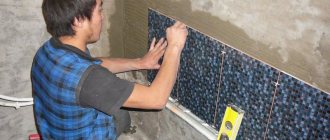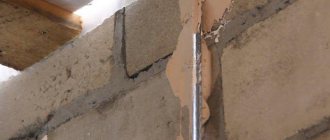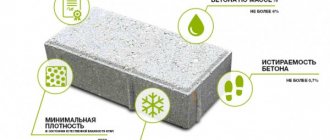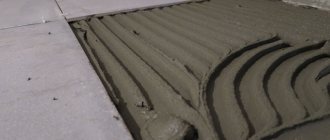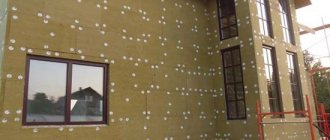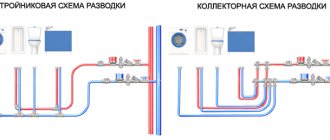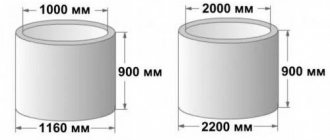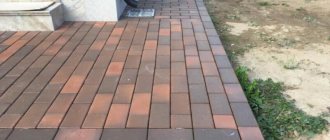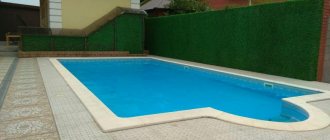Features and Benefits
Let's consider the distinctive characteristics and qualities of the concrete contact primer, which make it indispensable in finishing work:
- The product can be used on the ceiling, floor and even walls. The primer increases the tenacity so much that it allows you to keep the facing material in a vertical position.
- The material dries quickly. When drying, no unpleasant odor appears and no harmful substances enter the air. The speed of the process directly depends on the correctness of the work and the microclimate of the room.
- Concrete contact is moisture resistant. The product can be used as a waterproofing agent.
- Manufacturers are pleased with the service life of the primer. If the instructions are followed, the primer will last up to 80 years.
- The presence of pigment in the primer allows the surface to be covered as densely as possible. Thanks to the visible color, you will immediately notice missed spots.
- The concrete contact mixture has a consistency similar to sour cream. Thanks to this, the product is easily applied to the surface using a tool convenient for you.
- The mixture can be used not only by experienced craftsmen, but also by beginners. There is nothing difficult to use, you do not need to have any special skills.
Composition of concrete contact
The primer contains:
- styrene-acrylic dispersion as a binder;
- quartz sand fractions from 0.3 (for putty) to 0.6 (for plaster);
- Portland cement;
- fillers.
The primer is a viscous liquid suspension, usually pink (sometimes blue or purple) without a distinct odor. The dye is added to the composition to make it convenient to control the application and not leave bald spots.
Concrete contact mixes with water, but after drying it becomes water insoluble.
The primer is non-toxic and does not require the use of protective equipment when working with it; but it is advisable to wear protective gloves and ventilate the room.
Important!
When frozen, concrete contact loses its qualities. There are types of primers that can withstand several cycles of freezing and thawing without loss of properties.
Primer properties
Knauf Betokontakt not only strengthens weak surfaces and increases the adhesion of smooth substrates before plastering. The ability of the acrylic mixture to clog pores and microcracks makes it possible to reduce the consumption of viscous (liquid) finishing materials and retain the water in leveling solutions necessary for their normal setting. Thanks to this, the plaster does not delaminate or crack due to rapid loss of moisture.
The performance characteristics of the Knauf mixture are also worthy of attention. For example, its formula already includes fungicidal additives, which means that additional antiseptic treatment is no longer required. Concrete contact itself does an excellent job of protecting walls from mold, reducing your repair costs. To this it is worth adding the good vapor permeability of the created intermediate layer - it does not interfere with diffusion air exchange between the room and the street.
In some ways, the disadvantage of the primer is the need to quickly begin further work as soon as Betonokontakt Knauf dries. It is impossible to postpone finishing, much less carry out other activities in the room at the same time - a rough adhesive layer easily accumulates dust, worsening the properties of the preparation.
Characteristics and consumption
The Betonokontakt primer from the Knauf company is produced with a mineral filler of two fractions, on which the scope of application of a particular composition depends:
- 0.6 mm – used before rough thick-layer leveling;
- 0.3 mm - it is worth purchasing for preparing plastered surfaces before puttying.
The pink pigment introduced into the composition allows you to control the application and not miss a single area during processing.
Knauf technical characteristics:
- Acidity – neutral (pH 7.5-8.5).
- The drying time of the layer is from 3 hours, depending on the humidity and temperature in the room.
- Service life – up to 80 years. Although the material is still too “young” to confirm or refute the manufacturer’s statements.
- Wide temperature range of application - according to its characteristics, Concrete Contact can be called a primer for interior and exterior work. After drying, it retains its properties at -40..+60 °C, withstanding at least 5 freeze-thaw cycles.
- Possibility of application in any convenient way (brush, brush, roller, mechanical spraying).
- Absolutely environmentally friendly - the use of adhesive primer is allowed even in poorly ventilated areas and does not require respiratory protection. Its formula simply does not contain toxic solvents that can harm humans.
The primer consumption depends on the characteristics of the base: smoothness and porosity (absorbency). It will show the minimum result on tiles - 200 g/m2; on monolithic concrete of different densities this figure will increase to 250-350 g/m2.
The Knauf primer is completely ready for application. However, before starting, it is recommended to stir it with a drill with a mixer attachment at low speeds so that the fine sand is evenly distributed throughout the entire volume. Work is carried out only after cleaning and removing dust from the base. In this case, the temperature of the wall being treated should be within +5..+30 °C.
Unlike many similar mixtures, here the manufacturer allows the primer to be diluted with water in order to reduce material consumption per 1 m2 and simplify painting of the dispersion composition. However, for manual application the amount of water should not exceed 50 ml/liter. Firstly, a solution that is too thin will not allow you to create a continuous “coat”. Secondly, the sand will quickly settle at the bottom of the container and will have to be constantly stirred.
For soft substrates, as well as application by spraying, the mixture can be diluted with water in a ratio of 2:1. Alternatively, experts recommend using another technology. It allows you to reduce the consumption of Concrete Contact by 1 m 2, but at the same time obtain a high-quality result. Processing is performed in two layers:
Price
Concrete contact primer from different manufacturers
There are not many manufacturers of concrete contacts in the world that produce high-quality products. Each of them has its own characteristics and production secrets.
The most famous is the Knauf company. Knauf Betokontakt concrete contacts with fine-grained and coarse-grained fillers are successfully used in a variety of areas and are very popular among consumers.
Is it possible to apply concrete contact over paint?
Another oldest world-famous manufacturer is Ceresit. The universal concrete contact Ceresit CT 19, in addition to other useful qualities, is distinguished by its particularly effective use for tile-to-tile facing technology.
The European leader is the Feidal concern and, in particular, it produces Feidal Super Kontakt concrete contact for combined use, which has proven itself indispensable for the renovation of old houses with many coatings of drying oil and oil paint.
If there is a need or desire to carry out finishing work in a short time, then it would be correct to use concrete contacts with latex additives, which are characterized by particularly fast drying within 50-60 minutes.
Is it possible to apply concrete contact to wood?
Concrete contact can be produced not only as a ready-made solution, but also in dry form. Thus, the dry concrete contact mixture “Axton” for universal use with marble chips instead of quartz sand has technical characteristics no worse than those of liquid soils. Its operational technological feature is the ability to be used on unpolished and uncleaned surfaces.
The quality and reliability of concrete contacts is a privilege not only of well-known brands and historical enterprises. There are modern manufacturers that successfully master innovative technologies and produce high-quality products that meet international standards and GOST requirements in all respects.
GOODHIM GBK concrete contact primer has all the technical characteristics of high-quality concrete contact soil: it reliably binds a variety of finishing materials to a hard surface, provides waterproofing, retains its properties for 30 years, etc. At the same time, it has a very important property - an increased shelf life - 24 months, which is twice as long as its analogues!
Is it possible to apply concrete contact over oil paint?
Depending on taste and financial capabilities, everyone must decide for themselves which concrete contact company is better to choose.
How to apply concrete contact
In order for the primer to perform its functions, you must adhere to the rules for its application.
Preparatory work
Before applying the primer, it is necessary to remove debris and excess dust; if there is old paint or plaster that does not adhere well, it must be knocked down and cleaned with metal brushes; Wash dirty surfaces with soapy water or soda solution and dry thoroughly.
When storing the material, sand settles to the bottom, so before work it is necessary to thoroughly stir the primer so that the sand is distributed evenly.
Applying primer
There are two main ways to apply primer:
- with a brush or roller;
- spray gun.
Applying concrete contact with a brush or roller is a rather slow and labor-intensive process.
It is necessary to apply it so that the sand is distributed evenly over the surface of the base.
It is much more productive to apply the primer with a spray gun. In this case, the air flow beats the residual dust and distributes the sand evenly over the surface.
In addition, the spray gun allows you to significantly save time.
Sometimes it is recommended to apply concrete contact using a roller, which is certainly faster and more convenient than applying it with a brush.
To do this, the primer will have to be diluted with water, but adding water will weaken the adhesive composition. As a result, the sand will not adhere well, which is noticeable even when applying the primer: the sand crumbles directly onto your hands. In addition, the fleecy surface of the roller absorbs large amounts of sand. The primed surface acquires an uneven, bald, crumbling texture.
Concrete contact is applied to the base in one or two layers. After drying, a durable film appears on the surface of the base, resembling sandpaper to the touch. It is this structure that allows you to reliably hold finishing materials.
Features of applying concrete contact for outdoor work
Concrete contact can be used at ambient temperatures from +5 to +25°C. When performing finishing work in the cold season, you need to use special frost-resistant types of primer intended for outdoor work.
How to choose concrete contact correctly
The question arises: how not to make mistakes when buying?
Choose a primer produced by well-known companies that are sensitive to their reputation. If you see an expensive brand of concrete contact at a too low price, this is a reason to be wary.
You can evaluate the quality of the primer visually. High-quality material always has a pink, blue or purple color to control the evenness of the coating. If the primer is almost white, this is a sign that it may have been heavily diluted with water.
Primer: types and properties
The main purpose of using a primer mixture is to impart strength to the surface and increase the service life of the coating applied to it in the future.
A primer on the walls is indispensable before wallpapering - it can penetrate deep into the surface being pasted and mask defects (cracks and holes).
A primer for wallpaper can prevent damage to the roll and the appearance of mold or mildew underneath it.
A properly applied mixture can improve adhesion between the wall and the coating, which will lead to a reduction in the cost of finishing materials.
There are several types of primers - acrylic, oil, contact, concrete contact.
Let's look at each of them in detail:
- acrylic - a universal mixture of deep penetration, capable of imparting strength to a weak base. Most often used in residential areas to level walls. However, it can be used on ceilings and floors. Penetrates to a depth of 1 centimeter and, when hardened, forms a durable coating with excellent adhesive properties. Not recommended for working on ferrous metals;
- contact primer with the addition of quartz sand enhances surface adhesion and, thanks to its composition, penetrates deeply into walls, effectively filling cavities;
- an alkyd or oil primer mixture is used to treat a wooden or metal surface. Can be applied to rust, as it combines the properties of paint and anti-corrosion properties;
- drying oil or alcohol primer is perfect for working on wood - if you preheat the surface to be treated, you can significantly reduce the drying time;
- concrete contact is ideal for the walls and ceiling of an ordinary apartment.
Video:
There are also mixtures less popular among the average person, which are most often used only by professionals:
- on concrete or lime-sand walls they use a silicone solution, which hardens in 5 hours;
- areas with poor absorption - utility rooms and workshops - are treated with a polyurethane compound;
- To obtain a neutral color that does not show through the wallpaper, a pigmented primer is used on the surface.
The drying time of the primer depends primarily on the type. So, the oil, contact and deep penetration primer mixture hardens in about a day. Acrylic primer dries in just 10 hours.
Therefore, before purchasing the mixture, study the label - the manufacturer always indicates the drying time of the primer mixture.
If we talk about average values, then the mixture dries completely in about 4 hours at a temperature of 25 degrees Celsius and a humidity of 65%.
Remember that the higher the humidity in the room, the longer it will take for the deep penetration primer to harden, so you can speed up this process by simply opening the windows, of course, if the weather outside is clear and without rain.
If the room has high humidity levels and there is no way to provide air flow, then the time indicated on the box can be doubled.
How long should the primer dry before wallpapering?
There are several factors that influence the drying speed:
- the mixture will harden slowly if the room temperature is extremely low or, conversely, high;
- the thicker the layer is applied, the longer it will take to dry;
- How long the newly applied primer will take to dry is also affected by its composition - the deeper the mixture penetrates, the longer you will have to wait for it to harden.
Do not forget about the operating time of the primer solution - the period until the mixture retains its adhesive properties.
The primer must be used immediately after preparation, otherwise it will lose its effectiveness.
The primed surface also plays an important role.
If the primer mixture is applied in 2-3 layers to cement-lime plaster, then you will have to wait about 6 hours.
If you apply a primer to a regular wall before puttying, it will take 2 to 3 hours for the mixture to harden.
After a visual assessment, run your hand over the wall - a smooth and dry surface will indicate that priming was successful.
What properties does concrete contact give to surfaces?
Applying concrete contact provides many advantages:
- Strengthening surfaces.
- Giving surfaces waterproofing properties. (In addition to concrete contact, there are other waterproofing impregnations. If subsequent plastering with cement mortar is planned, it is advisable to use other impregnations rather than concrete contact).
- Formation of an adhesive film that allows high-quality application of finishing materials to the surface.
- The concrete contact coating does not interfere with gas exchange (primed walls “breathe”).
- The surface is protected from mold and mildew.
- Preventing the absorption of water from the plaster mixture, which reduces the strength of the plaster layer, by the base material.
Advantages of concrete contact:
- availability;
- easy application;
- added dye to control the uniformity of application;
- quick drying and the ability to continue finishing work without wasting time;
- safety, absence of harmful effects on the human body;
- ease of use (convenient consistency, concrete contact primer is supplied ready for use and does not require dilution with water);
- fire and explosion safety;
- durability.
What not to do
If you wish, you can find reviews or videos that say that the plaster/tiles have fallen off from Betonkontakt. To prevent this from happening, apply primer only to recommended substrates. In addition, you should not do the following things:
- Dilute the plaster or putty composition with more water than indicated on the package. Yes, it’s easier to work with, but as a result, the putty may collapse.
- Do not apply the composition to frozen ground.
- Do not apply Betonokontakt to an unprepared surface (remove all detachable parts, degrease, remove dust).
- Do not apply BC on a damp base. Dry only.
- When working, do not forget to periodically mix the contents, as sand particles (granules from some manufacturers) fall down.
- You cannot continue work until the primer layer has completely dried (indicated in the instructions).
- Do not work at temperatures below +5°C. This does not mean that it cannot be used for outdoor work. It is possible, but it must be applied at positive temperatures.
- Do not allow dust to enter. It sticks very well to the adhesive surface, but then falls off along with the plaster. If the surface is dusty, another treatment is necessary.
- Do not use a composition that has expired or has been frozen. The exception is frost-resistant compounds (there are such). Before use, they must be defrosted, wait until the temperature rises above +5°C, then you can work. By the way, the inscription “frost-resistant” does not mean that it can be applied at sub-zero temperatures. It can only withstand several defrost/freeze cycles before application without loss of properties.
- Do not add water, even if it seems that the composition is too thick. Unless the manufacturer described this possibility in the instructions. But so far we haven’t seen any of them.
And for Betonokontakt to work, it must be “real”. There are a lot of fakes, so you have to be careful. And to be sure, you can check. Pre-treat a small piece of wall with BC according to the instructions. Apply the planned layer of plaster/putty. Wait until it dries and try to tear it off. If everything is done correctly, nothing will work out for you. They say that high-quality Betokontakt allows you to apply plaster even on glass. By the way, you can try it.
Purpose and scope
Concrete contact is a special type of primer for substrates that do not absorb water. If plaster is applied to such bases without prior preparation, it will most likely fall off when drying, since the surface of these bases is usually smooth and there is simply nothing for the plaster to cling to. To prevent the plaster from falling off, use Beto-contact. And it really works, but you just need to know when it is needed.
Operating principle of Concrete Contact
The composition is not cheap, and it is recommended to use it anywhere. In order not to waste your money, you should know exactly its properties and scope of application. In general, information is on each can, but sellers (and some builders) advise a different use. But not everyone needs to be trusted.
What surfaces to apply to?
Concrete contact forms a sticky, rough layer with abrasive inclusions on the surface. Plaster/putty also adheres well to this layer. Abrasive particles - grains of sand or crystals - provide additional support for the finishing layer. In general, the task of Concrete Contact is to increase adhesion to complex substrates. But not to everyone.
What should Betonkontakt be applied to? As already mentioned, it is intended for substrates that do not absorb water. There are not many of them:
- Smooth concrete that is almost poreless. Usually these are concrete panels in panel houses, columns in modern monolithic ones. If the concrete is loose and porous, a different primer is needed.
Betokontakt from Knauf has a pink dye in its composition.
- Ceramic tile. It is not necessary to knock down the old tiles when laying new tiles. Although, if possible, it is better to shoot it down. If for some reason this cannot be done, go over the top of the tile twice with concrete contact and you can continue working.
- Wooden fragments. There is simply no other way to apply plaster to wood. But the wood must be dry.
- Metal. This base is 100% non-absorbent of moisture and in order for the plaster to stick to it, a layer of BC is needed.
This is what Concrete Contact is for. There are no other recommended surfaces. Advice to apply on plaster under putty, under decorative plasters is all unnecessary. There is no need for this processing, because only the cost increases, but does not affect the result or only worsens the situation. Putty will work great on fresh plaster, just like other finishing materials.
Option from Prospectors - Beton-Contact
There is one piece of advice: it is better to use concrete contact with coarse grain if you apply plaster and with fine grain for putty.
Moreover, the advice to apply Betokontakt to wooden and metal surfaces is specifically for fragments. For example, beams, protruding parts of structures. This is again the moment where a bookmaker is needed. There are other technologies for plastering wooden walls, and if there is only a fragment, it is advisable to use this composition.
Is concrete contact necessary over oil paint?
Finishers also use Betonkontakt over oil paint. Most people advise removing the paint anyway, because both with and without concrete contact, the plaster under its own weight can separate from the paint. If the composition is firmly ingrained and cannot be removed by any means, you must:
- Be sure to thoroughly degrease the surface.
- Remove smoothness using abrasive treatment - coarse sandpaper or a wire brush. It doesn’t matter what, as long as it works.
- Make notches using a chisel or axe.
Please note that some manufacturers position their Betokontakt only for interior work
- Remove dust. You can wash it, you can vacuum it. The main thing is to be thorough.
- Apply the first layer of concrete contact.
- Dry.
- Apply a second layer of concrete contact.
- Dry.
- You can putty, plaster, lay tiles.
In this case, it is also clear why Concrete Contact is needed and how it works. But it is quite possible to stop before the first application of Concrete Contact. If there are notches of sufficient area, both the plaster and the tile will stick. Use a suitable primer to fill any “chips” in the wall and, once dry, apply the next material.
Olimp has designated its Contact-Grunt as a product for decorative plasters and ceramic tiles
Many people assume that the sticky surface that Betokontakt leaves will hold better. In general, it works, but only if you do everything as written. And yes. Drying is complete and final. The expiration date is indicated on the can and differs depending on the manufacturer. The shortest drying period is 3-4 hours for Betonkontakt Fedal, the longest is about 24 hours for some cheap ones.
Specifications
The great popularity of the Betonokontakt primer composition is due to its excellent technical characteristics:
- Drying time. It takes 2 - 2.5 hours for the applied layer of primer to dry completely, after which you can immediately begin the next stage of repair and construction work.
- Moisture resistance. When applying a primer to a surface, the liquid penetrates deeply into the pores of the material being treated and forms a waterproof film that does not allow moisture to penetrate inside. Therefore, this material is ideal as a waterproofing agent for floor screeds or as a preservative for plastered external and internal walls.
- Durability. Manufacturers guarantee long-term preservation of the operational properties of the primer composition for up to eight decades. Such a long period is quite enough for interior decoration.
- Consumption rates. Depending on the type and type of surface being treated, the standard consumption ranges from 200 to 400 g/m2. There are cases when Betonokontakt has to be applied in two layers, for example, on an absorbent surface of overly porous concrete or rough cement plaster.
5. Color. Concrete contact is a plastic, slightly viscous pink liquid with a characteristic smell of PVA glue. The pink color gives an undeniable advantage to monitor the correct application of the primer layer: gaps and unpainted areas of the walls are immediately visible.
6. Packaging. The mixture is packaged in plastic containers of 5 and 20 kg. Such packaging with different weights allows for more economical use of the material according to the standardized consumption.
The guaranteed shelf life of Betonokontakt in undamaged containers is 18 months.
Composition and main characteristics
Concrete contact is a suspended solution based on acrylic, which includes purified sand, cement and specific fillers, including fungicides that prevent the growth of mold. The rough surface is created by a quartz filler with particles of 300-600 microns. The mixture has a high degree of adhesion due to polymer adhesives.
The basic composition of concrete contact includes:
- acrylic dispersion;
- quartz sand;
- cement;
- chemical modifying additives.
READ MORE: Siding Tecos - Facade panels. Siding and clinker
Various chemical composite additives that manufacturers add to their products give the primer layer the following properties:
- vapor permeability (allows the surface to “breathe”);
- hygroscopicity (perfectly absorbs moistened moisture, which is important when applying plaster or putty);
- resistance to mechanical influences (shocks, vibrations);
- resistance to biological interaction (prevents the appearance of mold).
Concrete contact is a harmless building material that does not harm the environment. Disinfecting components prevent the appearance of pathogens and insects.
Due to their neutral acidity, such solutions do not cause corrosion of metals and do not react with lime. Color pigments improve the visibility of primer application.
Concrete contact primer: features and consumption per 1m2
A primer is a unique solution that is used to prepare a specific surface for finishing, such as painting. The use of such a building mixture allows you to level the surface, get rid of any defects on the wall and eliminate small cracks.
One of the most popular types of primer is concrete contact, the use of which greatly simplifies further finishing work.
Main characteristics and properties
Concrete contact is a building mixture based on acrylic, which also includes cement, sand and special additives. This mixture is actively used to increase the adhesion of surfaces that do not absorb moisture well, before plastering, laying tiles and carrying out other finishing work.
Among its main advantages are the following:
- high drying speed. Further finishing work can begin a few hours after applying the primer;
- resistance to moisture. During the drying process, a special film is formed that does not allow water to pass through;
- durability. According to the manufacturing company, the concrete contact primer does not lose its qualities for 80 years.
Thanks to its unsurpassed properties, concrete contact has established itself as a unique material that is durable, does not require a lot of drying time and does not allow moisture to pass through. It is these properties that allow you not to worry about the quality of the repairs done.
How to determine the consumption of concrete contact?
The consumption of concrete contact per 1 m2 depends on many factors, among which the first place is occupied by the characteristics of the treated surface
It is not the type of surface itself that is important, but the porosity. It determines how much primer will be absorbed, which has a direct impact on its consumption per m2. Consumption table for concrete contact primer from different manufacturers
Consumption table for concrete contact primer from different manufacturers
Depending on the porosity, the following types of surfaces are distinguished:
- Porous surfaces, which include brick or sand concrete. The primer is absorbed quite intensively, which leads to consumption of concrete contact up to 0.5 kg per m2. If the porosity is too large, then you will first need to treat the surface using special solutions.
- Surfaces with medium porosity. These include concrete and concrete tiles. Concrete contact consumption is about 0.3 kg per m2.
- Low-porous surfaces for which primer consumption is minimal - 0.1-0.2 kg per m2.
Is it possible to reduce primer consumption?
Most people wonder whether it is possible to reduce the consumption of concrete contact primer. The answer is definitely no. First of all, this building mixture has an affordable price, so there is no point in saving on it. In addition, this can cause the material to decrease in strength, which will begin to crack or peel over time.
It should be remembered that the quality of the primer and the work done to apply it has a direct impact on future finishing work and the quality of the entire repair as a whole. If you reduce the amount of concrete contact primer per m2, the surface will lose its ability to adhere. This may cause the coating to separate from the substrate in the future.
Reducing primer consumption may result in loss of surface adhesion
The primer plays an important role in the process of ensuring waterproofing of the surface, which can be compromised when the amount of solution per m2 is reduced
We should also not forget about an important feature of some finishing materials, which is that some coatings can dry out. The fact is that they contain gypsum or Portland cement, and drying out becomes a natural reaction to a decrease in the amount of water. Thus, the use of concrete contact is important for the future of all repairs
Thus, the use of concrete contact is important for the future of all repairs
All the nuances of using this building mixture should be taken into account. The consumption level of concrete contact per m2 depends on the type of base and its porosity. You should not save when using a primer, as this can negate all further finishing work.
You should not save when using a primer, as this can negate all further finishing work.
This is interesting: Do-it-yourself renovation of a small kitchen in Khrushchev
Reliable manufacturers of concrete contacts
There are companies on the building materials market that have long established themselves. The primers from these manufacturers differ in composition, purpose and price. The cost is quite affordable: for 5 kg you will have to pay only 300-600 rubles.
Axton
This company produces a wide range of mixtures. The first representative is a high quality dry primer. It is used to treat any surfaces. Before use, add the required amount of water to the concrete contact and stir. The advantage of this material is its high drying speed: at room temperature, the composition sets in 2 hours. A small consumption is declared (300 g per 1 m2), but in reality it turns out to be more.
Ceresit
This water-dispersion primer differs from others in that it is best to apply it with a brush; using a roller is not recommended. It covers smooth surfaces; this concrete contact contains fine-grained quartz sand. The primer must not be diluted with water: high humidity and liquid that gets on the treated base will lead to a loss of properties of the material. It is used only for indoor work.
Knauf
The most famous brand in the domestic construction market. The main components of this material also include fine sand fractions. It is generally accepted that this primer has the best characteristics among other competitors. They make it possible to obtain ideal adhesion to glossy surfaces, such as glass. The first layer under normal conditions dries in an hour; final hardening takes approximately 4 hours. Consumption - about 350 g per 1 m2.
Prospectors
This primer is a domestic manufacturer, but the place of “birth” does not detract from its advantages. The primer mixture is made on the basis of latex. Concrete contact is used for surfaces that do not absorb moisture well - concrete tiles. Due to its low price and low consumption (200 g/m2), the composition is often used when installing self-leveling floors. The product does not require thorough stirring: the contents of the jar are simply shaken.
Optimist
Almost the only company that produces not only a decent primer for treating indoor surfaces, but also high-quality concrete contact intended for outdoor use. These compositions are ideal for preparing bases before applying gypsum, polymer material, and before facing with cement slabs. The minimum drying time for the primer is 3 hours, the maximum is 4. Material consumption is 300 g/m2.
Information about concrete contact: consumption, features of surface preparation and its application - the topic is necessary, but not complicated. Those who have become closely acquainted with the universal material have already become convinced of this. For example, the master from this video:
Real experience of using “Betonokontakt”
And now from theory to practice. The master had to completely prepare the walls of the kitchen room for laying tiles in the work area and for wallpapering other walls. Below is the sequence of work performed.
First you need to get rid of the old tiles, for this the master used a hammer and chisel, and safety glasses. Using these tools I knocked off old tiles.
I worked from top to bottom, it’s more convenient. Some tiles were flying off. I had to try.
The second stage is getting rid of the old paint on the wall. Using a spatula, the surfaces of the kitchen walls were treated. In places where the paint could not be removed, it was decided to leave it.
Removing oil paint from a wall using a spatula
To get rid of small flakes of paint, we went over the walls with sandpaper.
Since a layer of grease could form in the kitchen, given the purpose of the room, all surfaces were treated with a solvent and degreased.
Don't forget about the benefits of serifs. The depth of the notch should be slightly deeper than the paint coating. Serifs should be applied in an amount of approximately 100 pieces per square meter. m.
Now you can start priming. Use a roller or a regular construction brush.
After a day you can do the plaster.
Comparison of manufacturers
There are many positive reviews from the companies Ceresit, Knauf, as well as from the domestic manufacturer Bolars. To purchase high-quality material, it is advisable to contact only those stores that have at least some trust. You should also always check certificates and ask consultants for the production date of the primer
This is important since the shelf life of concrete contact usually varies from 6 to 12 months
READ Types of glue for linoleum on concrete floors and gluing technology
When choosing a primer, you need to remember that different manufacturers may offer products for different purposes and applications:
- Ceresite. The mixtures from this company are intended for preparing walls for plastering with cement-sand mortar or gypsum. They are also used for laying tiles or applying putty.
- Knauf. This concrete contact is used for monolithic concrete, wet screed, reinforced concrete structures and floors.
- Bolars. Provides good water-repellent quality to gypsum, polymer and cement bases. It can also be used for exterior decoration. Before puttying, a composition is applied whose fraction size is 0.3 mm. To prepare for plastering, you need to take 0.6 mm.
- Prospectors. The company produces products called “Universal”. This concrete contact is fully justified. The composition contains special additives that increase water-repellent qualities and frost resistance. They also impart antiseptic properties. This material can be used both indoors and outdoors.
READ Which cement is better to choose for the foundation of a private house
It is advisable to first buy one of the smallest buckets of concrete contact in order to check the quality in a small area. This will prevent you from wasting money if you get a low-quality product.
Manufacturers and possible replacement
As already mentioned, almost any manufacturer of building mixtures has Betonokontakt, Beto-Kontakt, Beton-Kontakt or something similar. If you like other blends from this manufacturer, it makes sense to try this one. There are local companies that, despite the good quality of their products, are represented only in some regions. So not everyone is included in the list, but those who have a wider “coverage”. According to reviews, I liked working with Betokontakt from the following companies:
- FEIDAL (Feidal). This is the developer of the composition, so it’s not surprising. Moreover, the price is not too exorbitant, and the quality is high.
- Knauf (Knauf). Just keep in mind that the composition is not waterproof. That is, it is very important to mix the plaster mixture or putty correctly - do not overdo it with water.
- Eskaro (Eskaro). Work only in a ventilated area, as it has a strong ammonia odor. But it’s convenient to work with, the composition fits well.
Another German composition, Shtock, is distinguished by its filler - marble chips and high water-repellent properties.
- Ceresit. Lots of fakes. It has a pink pigment, which makes it easier to control the quality of processing.
- Plitonite. After stirring, the solids settle out slowly, so it's a good composition. It also copes with the task with five marks.
- Pufas. It sticks a little less, but overall not bad.
- Found. It's called Bettokont. Requires constant stirring, and dries in 1-2 hours, the result is normal. Recommended only for gypsum plasters.
- Olympus. Despite the low price it gives good results.
- Prospectors. Composition with a large fraction, drying time - 2-4 hours.
- Bolars. Very thick, difficult to apply, takes at least 24 hours to dry.
The list includes companies operating in different price segments. The more expensive ones usually apply a little better. Cheaper ones will have to be mixed more often, and they are more difficult to apply. When processing, try not to leave bald spots. If found already in the drying process, apply a layer and wait for complete drying time. This is better than having to redo the peeled off piece later.
People often ask whether Betonokontakt can be replaced with something. The only possible option is Ceresit ct-16 primer. It gives a similar effect, but the cost will probably be more expensive.
Is it possible to apply plaster over old paint?
If you have at least once in your life dealt with treating walls yourself, then you probably know that the instructions for finishing materials clearly indicate the need to remove the old coating before applying plaster. This is due to the fact that when the old paint interacts with the leveling solution, the latter may begin to gradually fall off and lose its original appearance.
Is it possible to apply plaster over old paint? In most cases, there are no difficulties when removing old paint; it can be easily removed with a spatula. However, often old paint sticks quite well and is very problematic to remove. In such situations, experienced specialists recommend applying plaster directly over the paint layer.
It is worth noting that after plastering, oil paint does not lose its technical, in particular adhesive, characteristics. However, after some time, the plaster will begin to crumble and fall off. There is a very effective way to avoid this problem - the surface under the plaster must be covered with a layer of primer.
In the video: how to remove oil paint from walls.
What to apply
You need to not only know why Concrete Contact is needed, but also how and with what to apply it. It just seems like there is nothing complicated about it, but try it first. The composition is often thick, approximately like kefir, and sometimes thicker. Moreover, it contains grains of sand and crystals, which it is very desirable to distribute evenly over the entire surface, and not collect in one place. In general, it's not that simple. There are some tips:
- It is best to work in protective clothing, and it is advisable to cover everything. It is washed off from the skin with great problems; it is removed from the hair only along with the hair. To make it easier to wash off unprotected areas of the skin, cover it with a thick cream or some kind of oil. When treating the ceiling, it is advisable to protect your face, even if you have applied cream/oil to your skin. At the very least, glasses are a must.
Applying Betonokontakt primer is not so easy
- When treating a large area, it is easier to apply with a roller. It is more convenient to take it in a size that fits into a bucket. It is better to work with a fleecy one - with a pile of 12-18 mm. Yes, some amount of the composition is absorbed, but it is really more convenient to work this way than with foam rubber, which very quickly becomes “wooden”. Moreover, even in this case, after some time the pile will become clogged with sand. As you work, remove the sand on the edge of the bucket, you can try with a spatula. Basically, clean it up. If it can no longer be cleaned and “doesn’t work”, get a new one.
- For processing not too large surfaces or in corners, it is more convenient to work with a brush. The pile is medium or even short. Here it is more convenient for anyone. It’s just hard to manage the long one when it’s full of sand. During the application process, sand must be periodically removed (on the edge of the bucket). The brush wears out quickly, so with large volumes of work you will have to change it several times.
There is one more trick - attach a brush or roller to a stick about a meter long - and you don’t need a stepladder when working on walls, and keep yourself away from yourself - fewer drops will fly onto your clothes and into your face.
